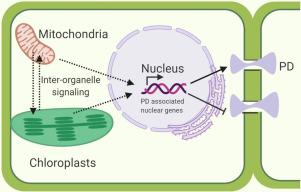Current Opinion in Plant Biology ( IF 9.5 ) Pub Date : 2020-11-13 , DOI: 10.1016/j.pbi.2020.09.005 Mohammad F Azim , Tessa M Burch-Smith

|
Plasmodesmata allow movement of metabolites and signaling molecules between plant cells and are, therefore, critical players in plant development and physiology, and in responding to environmental signals and stresses. There is emerging evidence that plasmodesmata are controlled by signaling originating from other organelles, primarily the chloroplasts and mitochondria. These signals act in the nucleus to alter expression of genetic pathways that control both trafficking via plasmodesmata and the plasmodesmatal pores themselves. This control circuit was dubbed organelle-nucleus-plasmodesmata signaling (ONPS). Here we discuss how ONPS arose during plant evolution and highlight the discovery of an ONPS-like module for regulating stomata. We also consider recent findings that illuminate details of the ONPS circuit and its roles in plant physiology, metabolism, and defense.
中文翻译:

细胞器-细胞核-胞浆信号(ONPS):其在植物生理,代谢和胁迫响应中的作用的最新进展
疟原虫允许代谢物和信号分子在植物细胞之间移动,因此是植物发育和生理以及响应环境信号和胁迫的关键因素。越来越多的证据表明,疟原虫受其他细胞器(主要是叶绿体和线粒体)的信号传导控制。这些信号在细胞核中起作用,以改变控制通过纤毛虫和纤毛孔本身运输的遗传途径的表达。该控制电路被称为细胞器-细胞核-胞浆信号传导(ONPS)。在这里,我们讨论了ONPS如何在植物进化过程中出现,并着重介绍了调节气孔的类ONPS模块的发现。我们还考虑了最近的发现,这些发现阐明了ONPS电路及其在植物生理中的作用的细节,

























 京公网安备 11010802027423号
京公网安备 11010802027423号